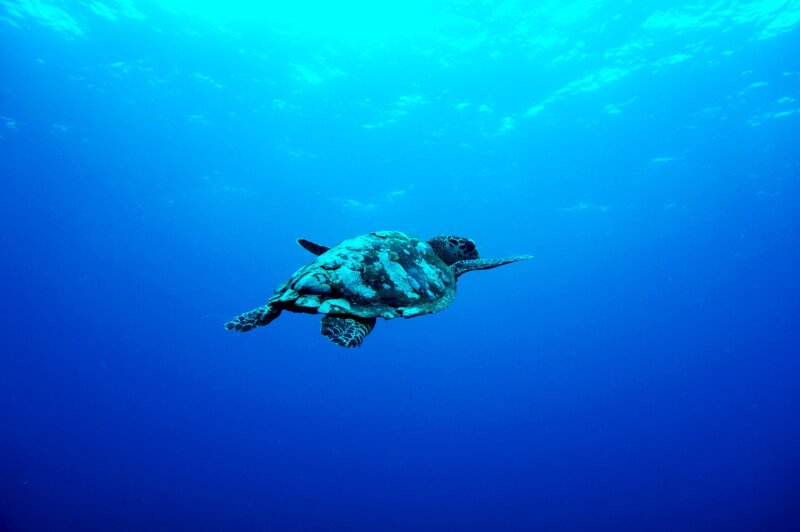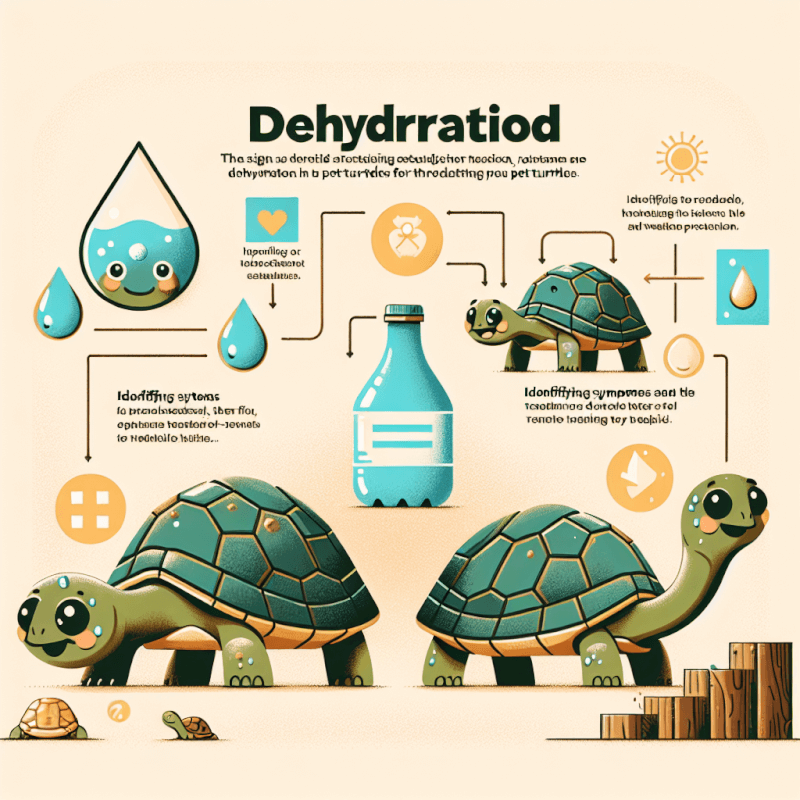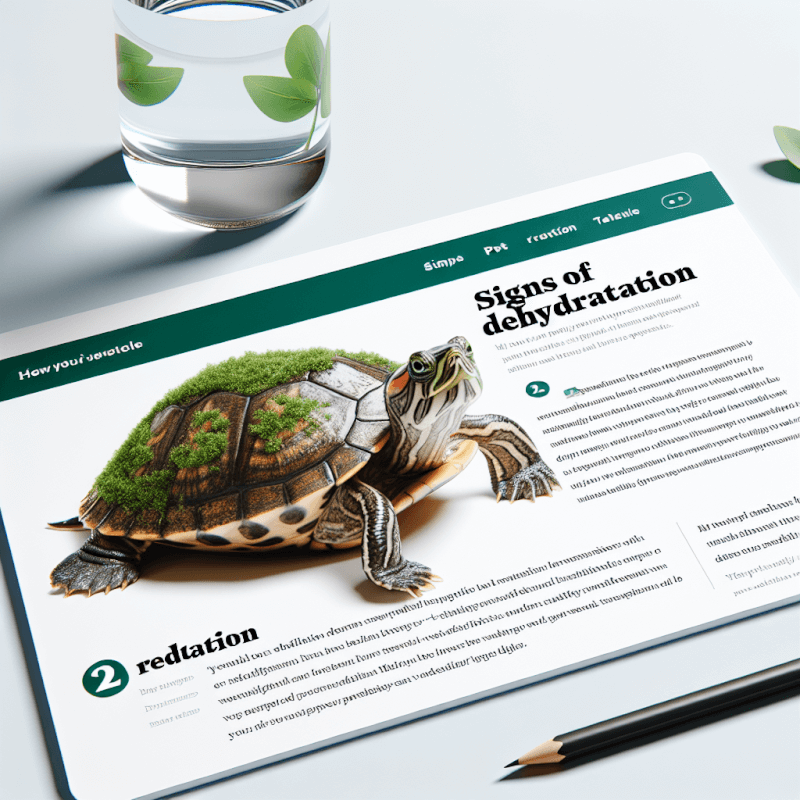Have you ever wondered if your turtle is properly hydrated? It’s important to ensure that your shelled friend is getting enough water to stay healthy and happy. But how can you tell if your turtle is dehydrated? In this article, we’ll explore some common signs and symptoms to look out for, so you can keep your turtle’s hydration in check and provide the best care possible.
Physical Signs
Dry Skin
One of the physical signs that indicate dehydration in turtles is dry skin. When a turtle does not have enough water in its system, it can lead to dry and flaky skin. You may observe that the skin appears dull and lacks the usual shine and moisture. Additionally, a dehydrated turtle’s skin may feel rough to the touch. If you notice any of these signs, it is essential to take immediate action to rehydrate your turtle.
Sunken Eyes
Another physical sign of dehydration in turtles is sunken eyes. When a turtle is dehydrated, the lack of fluids in its body causes the eyes to appear recessed into the skull. The eyes may seem smaller and more deeply set than usual. This is because the surrounding tissues lose moisture, making the eyes appear sunken. If you notice this symptom, it is crucial to address the dehydration promptly to prevent further complications.
Wrinkled Shell
A dehydrated turtle may exhibit a wrinkled shell as a physical sign of dehydration. The shell is typically smooth and plump in a healthy turtle with adequate hydration. However, when a turtle lacks sufficient water intake, its shell can lose moisture and become dry. This can cause the shell to appear shriveled and wrinkled. If you observe any abnormalities or changes in your turtle’s shell, it is important to provide proper hydration to prevent further damage.
Lethargy
Lethargy is a common physical sign of dehydration in turtles. When a turtle is dehydrated, it may become sluggish, inactive, and less alert than usual. You may notice a lack of energy in your turtle, with reduced movement and responsiveness to its surroundings. Dehydration can have a significant impact on a turtle’s overall well-being, so it is crucial to address this issue promptly and provide the necessary care.
Loss of Appetite
A loss of appetite can be an indicator of dehydration in turtles. When a turtle is dehydrated, it may not feel like eating or drinking. Dehydration can affect the turtle’s ability to digest food properly, leading to a reduced appetite. If your turtle shows a sudden disinterest in food or has not been consuming its regular diet, it is important to assess its hydration levels and take appropriate measures to rehydrate it.
Behavioral Signs
Decreased Activity
A dehydrated turtle may exhibit decreased activity levels as a behavioral sign of dehydration. Turtles generally have a pattern of activity that may vary depending on their age, species, and individual characteristics. However, if you notice a significant decrease in your turtle’s usual activity level, it might be an indication of dehydration. This reduced activity can be attributed to the lack of energy caused by dehydration. Monitoring your turtle’s behavior and addressing any signs of dehydration promptly is essential for its well-being.
Hiding
Hiding behavior is another behavioral sign that can indicate dehydration in turtles. When turtles are dehydrated, they may seek shelter or hide in an attempt to conserve moisture. You may observe your turtle spending more time in its hiding spot or seeking refuge in secluded areas. This behavior allows the turtle to avoid excessive heat and retain any remaining moisture in its body. If your turtle displays this hiding behavior, it is crucial to monitor its hydration status and take appropriate steps to address the dehydration issue.
Lack of Interest
A dehydrated turtle may demonstrate a lack of interest in its surroundings or usual activities. This behavioral sign is often associated with the overall lethargy and decreased activity mentioned earlier. The dehydrated turtle might not engage in its usual interactions with its environment or show curiosity towards its surroundings. If you notice a significant change in your turtle’s interest levels, it is important to consider dehydration as a possible cause and take immediate action.
Avoiding Water
Turtles experiencing dehydration may show an aversion to water. They may avoid swimming or submerging themselves in water, which is unusual behavior for most turtles. This can be attributed to their instinctive knowledge that they need to conserve their remaining moisture. If you observe your turtle actively avoiding water or having a reluctance to enter its water source, it is crucial to assess its hydration status and provide the necessary care to prevent further dehydration.

Urine and Fecal Examination
Low Urine Output
A decrease in urine output can be an indicative sign of dehydration in turtles. A healthy turtle generally produces a regular amount of urine, which is necessary for eliminating waste products and maintaining proper hydration levels. However, when a turtle is dehydrated, its urine output decreases significantly. Monitoring your turtle’s urine output by observing its daily routines and checking its living environment can help identify any irregularities and prompt you to take appropriate actions to rehydrate your turtle.
Concentrated or Smelly Urine
Another key aspect to consider when examining a turtle’s urine is its concentration and odor. Dehydrated turtles experience a lack of fluids in their system, leading to concentrated urine. This concentrated urine often has a strong and unpleasant odor. If you notice a change in your turtle’s urine color, consistency, or smell, it is essential to address the dehydration issue and provide the necessary care to restore proper hydration.
Dry Feces
Dry feces can also indicate dehydration in turtles. When a turtle is dehydrated, its body retains as much moisture as possible, resulting in limited water content in its feces. Consequently, the feces become dry and hard, making it difficult for the turtle to eliminate waste. Regularly inspecting your turtle’s feces can help you identify any issues related to dehydration and take appropriate steps to rehydrate your turtle.
Dehydration Testing
Skin Pinch Test
The skin pinch test is a simple and effective way to assess the hydration status of your turtle. Gently pinch a small area of the turtle’s skin, such as the skin near its neck or tail. In a hydrated turtle, the skin should immediately snap back into place when released. However, if the skin takes longer to return to its original position or remains tented, it may indicate dehydration. Remember to perform this test gently and not to cause any discomfort to your turtle during the process.
Eyelid Pinch Test
The eyelid pinch test is another method to determine whether your turtle is dehydrated. Gently lift the turtle’s eyelid and observe the moisture level. In a hydrated turtle, the eyelid should be moist and have a healthy, glossy appearance. If the eyelid appears dry, sticky, or lacks moisture, it may suggest dehydration. Be careful when performing this test to avoid injuring yourself or causing discomfort to your turtle.
Blood Test
A blood test performed by a veterinarian can provide an accurate assessment of your turtle’s hydration levels. This test measures various parameters, such as electrolyte levels and kidney function, which give insights into the turtle’s overall hydration status. Consulting a veterinarian experienced in reptile care is recommended for obtaining precise results and appropriate guidance based on the blood test analysis.

Environmental Factors
Inadequate Water Source
One of the significant environmental factors that can contribute to dehydration in turtles is an inadequate water source. Turtles need access to a clean and constant water supply for drinking, soaking, and maintaining hydration. If the water source provided to your turtle is insufficient in terms of quantity or quality, it can lead to dehydration. Regularly check and ensure that your turtle has access to an ample supply of fresh, clean, and dechlorinated water.
Insufficient Humidity
Maintaining appropriate humidity levels is crucial for a turtle’s hydration. Insufficient humidity in the turtle’s enclosure can result in increased moisture loss from both its body and respiratory system. Turtles require a certain level of moisture in the air to prevent dehydration through their skin and respiratory passages. It is essential to monitor and regulate the humidity levels in the turtle’s habitat to ensure optimal health and prevent dehydration.
High Ambient Temperature
High ambient temperatures can contribute to dehydration in turtles. Turtles are ectothermic creatures, meaning their body temperature is regulated by external sources. When they are exposed to extremely high temperatures, they can quickly lose moisture through evaporation, leading to dehydration. Providing a suitable temperature gradient and shade within the turtle’s enclosure is vital to prevent excessive heat exposure and maintain hydration.
Common Causes
Inadequate Water Access
One common cause of dehydration in turtles is inadequate water access. Turtles require a constant supply of fresh water for drinking and soaking. If the water source is not easily accessible or if the turtle’s enclosure lacks a sufficient water area, it can lead to inadequate water intake and subsequent dehydration. Ensuring that your turtle has easy access to a suitable water source is essential for preventing dehydration.
Inadequate Humidity
Inadequate humidity levels within the turtle’s environment can also contribute to dehydration. Turtles rely on the surrounding air to maintain moisture in their skin and respiratory passages. If the humidity levels in the turtle’s enclosure are consistently low, it can lead to increased moisture loss and dehydration. Providing the appropriate humidity range specific to your turtle species is crucial for maintaining adequate hydration.
Illness or Disease
Various illnesses or diseases can cause dehydration in turtles. Infections, kidney issues, parasites, or other underlying health conditions can affect a turtle’s ability to retain fluids or lead to increased fluid loss. If your turtle exhibits signs of dehydration along with other symptoms of illness, it is crucial to seek professional veterinary assistance for a proper diagnosis and treatment.
Inappropriate Environment
An unsuitable environment can contribute to dehydration in turtles. Factors such as inadequate temperature regulation, lack of proper hiding spots, or inappropriate substrate can lead to stress and dehydration. Creating a suitable environment that meets your turtle’s specific needs and mimics its natural habitat is essential for its overall well-being and hydration.

Prevention
Provide Ample Water Supply
Preventing dehydration in turtles starts with ensuring they have access to an ample supply of water. The water source should be large enough for the turtle to fully submerge itself and should be easily accessible. Regularly clean and provide fresh, dechlorinated water to maintain optimal hydration. Additionally, consider adding a water filter or aerator to keep the water clean and oxygenated.
Ensure Proper Humidity
Maintaining appropriate humidity levels is crucial for preventing dehydration in turtles. Research and understand the specific humidity requirements of your turtle’s species. Use an accurate hygrometer to monitor the humidity levels within the enclosure and make adjustments as necessary. Providing a suitable humid hiding spot can also help your turtle regulate its hydration levels.
Regular Veterinary Check-ups
Regular veterinary check-ups are vital for the preventive care of your turtle. A veterinarian experienced in reptile care can perform thorough examinations, including assessing the turtle’s hydration status. They can provide guidance on proper husbandry practices, diet, and overall health maintenance. Routine check-ups help identify any potential issues early on and prevent dehydration or other health problems from developing.
Maintain Suitable Environment
Maintaining a suitable environment for your turtle is essential for its overall well-being and hydration. Ensure that the enclosure size is appropriate for your turtle’s species, allowing for ample movement and a comfortable living space. Provide suitable temperature gradients and lighting levels to mimic its natural habitat. Creating a stress-free environment with proper hiding spots and substrate choices can also contribute to your turtle’s hydration and overall health.
Immediate Care
Rehydrate the Turtle
When addressing dehydration in turtles, immediate rehydration is crucial. There are different methods to rehydrate a dehydrated turtle, depending on the severity of dehydration and the preferences of your turtle. Offer fresh, dechlorinated water to your turtle and encourage it to drink. If the turtle is not drinking voluntarily, you may carefully drip water onto its mouth using a dropper or syringe (without a needle). Soaking your turtle in lukewarm water for around 20-30 minutes can also facilitate rehydration through the skin and cloacal absorption.
Monitor Fluid Intake
While rehydrating your turtle, it is essential to monitor its fluid intake. Observe whether your turtle is drinking and note the quantity of water it consumes. This will help you determine whether additional intervention is required or if the turtle is adequately rehydrating. Continue to offer water and monitor fluid intake until your turtle’s hydration levels are back to normal.
Control Temperature and Humidity
Maintaining appropriate temperature and humidity levels during the rehydration process is crucial. Ensure the turtle’s enclosure is within the recommended temperature range for its species. Adjust the humidity levels to prevent excess moisture loss and promote rehydration through skin absorption. Providing a comfortable environment will reduce stress and encourage your turtle to drink or absorb moisture.

Seeking Veterinary Assistance
Professional Diagnosis
If you suspect your turtle is dehydrated or shows signs of other health issues, it is crucial to seek professional veterinary assistance. A reptile veterinarian can provide a thorough examination, analyze the turtle’s hydration status, and offer an accurate diagnosis. They may conduct tests, such as blood work, fecal examinations, or imaging, to further evaluate the turtle’s health and identify any underlying causes of dehydration.
Fluid Therapy
In severe cases of dehydration, a veterinarian may recommend fluid therapy to rehydrate the turtle. This involves administering fluids directly into the turtle’s body through subcutaneous or intravenous routes. Fluid therapy helps restore hydration quickly and efficiently, ensuring the turtle receives the necessary fluids and electrolytes.
Treatment for Underlying Causes
In addition to rehydration, addressing the underlying causes of dehydration is vital for the turtle’s long-term health. A veterinarian can determine if the dehydration is a result of an underlying illness or disease and recommend appropriate treatment. They may prescribe medication, provide dietary advice, or suggest environmental modifications to prevent further dehydration.
Conclusion
Dehydration is a serious issue that can significantly impact a turtle’s health and well-being. Being observant of physical signs, behavioral changes, and environmental factors can help you identify and address dehydration promptly. By providing ample water supply, maintaining proper humidity, and seeking regular veterinary check-ups, you can prevent dehydration in your turtle. In case of dehydration, immediate care and veterinary assistance are crucial to restore optimal hydration and ensure your turtle’s overall health and happiness. Remember to always prioritize your turtle’s hydration needs and provide a suitable environment for it to thrive.



